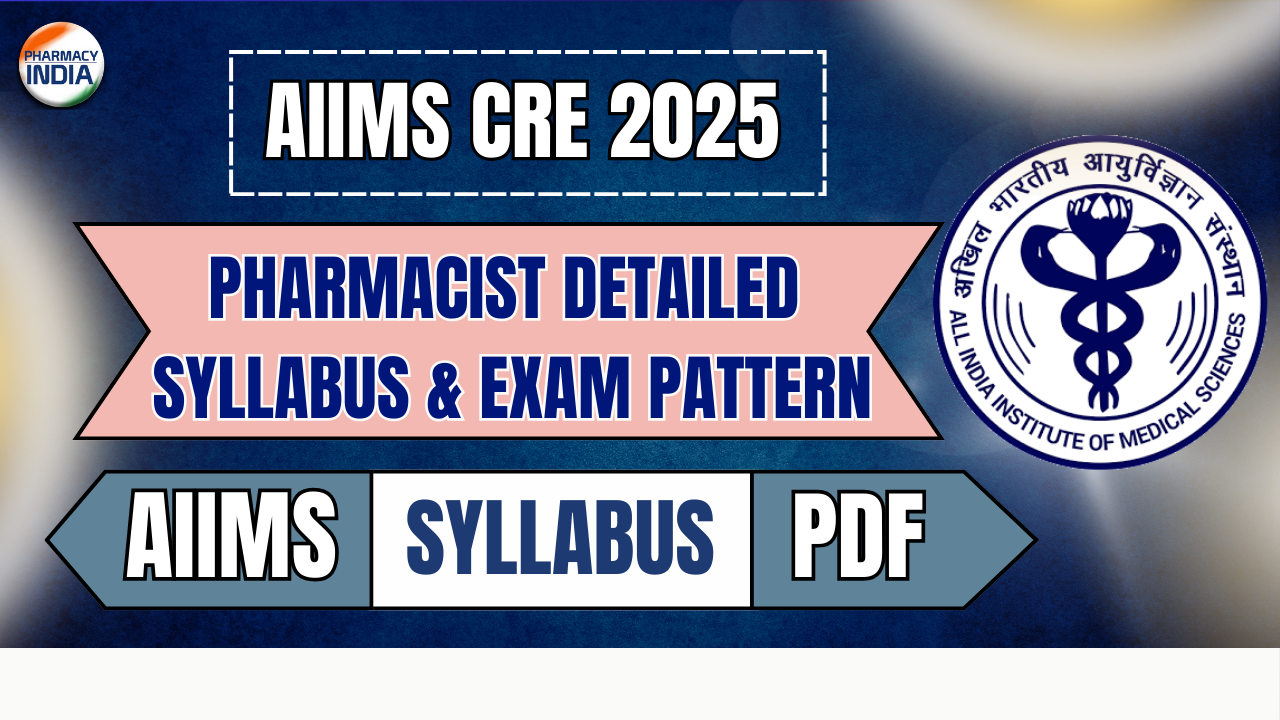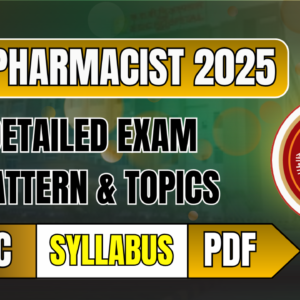WhatsApp D. Pharma Group
Join Now
Telegram D. Pharma Group
Join Now
Telegram Group Latest Pharma Jobs
Join Now
Telegram B. Pharma Group
Join Now
Telegram Medicine Update Group
Join Now
WhatsApp B. Pharma/ GPAT Channel
Join Now
AIIMS Pharmacist Syllabus & Exam Pattern (CRE-2025)
A Comprehensive Guide for Aspiring Pharmacists
AIIMS Pharmacist Exam Pattern (CRE-2025)
The selection for Pharmacist posts at AIIMS will be conducted through a Computer Based Test (CBT). The examination is designed to assess both general aptitude and core pharmacy knowledge. Below is the detailed structure of the exam:
| AIIMS Pharmacist (CRE-2025) Examination Scheme | |
|---|---|
| Feature | Details |
| Total Duration | 90 minutes (1.5 hours) |
| Total Questions | 100 Multiple Choice Questions (MCQs) |
| Total Marks | 400 Marks |
| Marking Scheme | +4 for each correct answer |
| Negative Marking | -1 for each incorrect answer (1/4th of the marks for the question) |
| Qualifying Marks | UR/EWS: 40% OBC: 35% SC/ST: 30% |
| Language of Exam | English only |
Structure of the Question Paper
The 90-minute CBT is strategically divided into two main parts to evaluate candidates comprehensively:
- Part 1: General Paper (20 Questions, 80 Marks) – This section is common for all posts and covers non-technical subjects like General Knowledge, Aptitude, and Computer Knowledge.
- Part 2: Domain Specific (Pharmacy) (80 Questions, 320 Marks) – This is the core section designed to test the candidate’s proficiency in the field of Pharmacy, based on the educational qualification (Diploma or Degree in Pharmacy).
Detailed Syllabus for AIIMS Pharmacist Exam
Part A: General Subjects
General Intelligence & Reasoning
- Analogies (Semantic, Symbolic, Number)
- Classification (Number, Letter, GK based)
- Series (Number, Alphabet, Mixed)
- Coding and Decoding
- Blood Relations & Family Tree
- Direction Sense Test
- Logical Venn Diagrams
- Syllogism
General Awareness & Current Affairs
- Current Events: National and International Summits, Awards, Sports Events.
- History: Indian Freedom Struggle, Ancient, Medieval, and Modern Indian History.
- Geography: Indian and World Geography, Rivers, Dams, National Parks.
- Polity: Indian Constitution, Fundamental Rights, Key Articles.
- Economy: Basic Economic terms, Indian Economy, Five Year Plans.
- Static GK: Books and Authors, Important Days, Countries and Capitals.
Quantitative Aptitude
- Number System & Simplification
- Percentage, Average, Ratio & Proportion
- Profit and Loss, Simple & Compound Interest
- Time & Work, Pipes & Cisterns
- Data Interpretation (Bar Graphs, Pie Charts, Tables)
English/Hindi Language Comprehension
- Vocabulary: Synonyms, Antonyms, One-word substitution
- Grammar: Error spotting, Fill in the blanks, Tenses, Articles
- Reading Comprehension
- Sentence Rearrangement (Jumbled Sentences)
Basic Computer Knowledge
- Fundamentals of Computing (Hardware, Software, Input/Output devices)
- Microsoft Office (Word, Excel, PowerPoint)
- Operating Systems basics
- Internet, Web Browsers, and Email fundamentals
- Common Keyboard Shortcuts
Part B: Domain-Specific (Pharmacy)
1. Pharmaceutics
- Dosage Forms: Detailed study of Solid, Liquid, Semi-solid, and Gaseous dosage forms.
- Pharmacopoeias: In-depth look at the Indian Pharmacopoeia (IP), British Pharmacopoeia (BP), and United States Pharmacopeia (USP).
- Metrology & Posology: Systems of weights and measures, dose calculation for infants and children.
- Unit Operations: Size Reduction, Size Separation, Mixing, Filtration, Drying, and Extraction.
- Sterile Products: Sterilization concepts, Aseptic Techniques, Parenteral Products.
- Tablet and Capsule Technology: Manufacturing, evaluation, and defects.
- Novel Drug Delivery Systems (NDDS): Introduction to sustained-release and controlled-release.
2. Pharmaceutical Chemistry
- Inorganic Chemistry: Limit Tests, Key Compounds like Antacids, Cathartics, and Electrolytes (ORS).
- Organic Chemistry: Fundamentals, Nomenclature with a focus on heterocyclic systems.
- Medicinal Chemistry: Detailed study including classification, SAR, mechanism of action for drugs acting on CNS, ANS, Cardiovascular System, Diuretics, NSAIDs, Hypoglycemic Agents, and Chemotherapeutic Agents (Antibiotics, Antifungals, etc.).
3. Pharmacognosy
- Introduction & Classification of Crude Drugs: Alphabetical, Morphological, Chemical, etc.
- Quality Control of Crude Drugs: Adulteration, Drug Evaluation (Organoleptic, Microscopic, Physical, Chemical).
- Phytochemistry: Isolation methods and tests for Alkaloids, Glycosides, Tannins, etc.
- Detailed Study of Crude Drugs: Laxatives (Aloes, Senna), Cardiotonics (Digitalis), Carminatives (Fennel), Drugs on Nervous System (Opium, Belladonna).
4. Human Anatomy & Physiology
- Scope and Introduction: Structure of animal cell, tissues of the body.
- Systems: In-depth study of Skeletal, Cardiovascular (Heart, Blood), Respiratory, Digestive, Nervous, Urinary, and Endocrine systems.
5. Biochemistry and Clinical Pathology
- Biochemistry: Metabolism of Carbohydrates (Glycolysis, Krebs Cycle), Proteins, and Lipids. Study of Vitamins and Enzymes.
- Clinical Pathology: Composition of Blood and Urine, and their significance in diagnosing diseases.
6. Health Education & Community Pharmacy
- Concept of Health & Communicable Diseases: Detailed study of causative agents, transmission, and prevention.
- First Aid, Nutrition and Health, Demography, and Family Planning.
- Community Pharmacy: Role of the pharmacist in public health and patient education.
7. Pharmacology & Toxicology
- General Pharmacology: Pharmacokinetics (ADME) and Pharmacodynamics.
- Systemic Pharmacology: Mechanism of action, therapeutic uses, and adverse effects of drugs on various body systems.
- Chemotherapy: Pharmacology of antibiotics, sulfonamides, and other antimicrobials.
8. Pharmaceutical Jurisprudence
- Key Acts: In-depth study of The Pharmacy Act, 1948; The Drugs and Cosmetics Act, 1940 & Rules, 1945 (Schedules C/C1, G, H, H1, M, P, X); Narcotic Drugs and Psychotropic Substances Act, 1985.
- Code of Pharmaceutical Ethics.
9. Drug Store and Business Management (DSBM)
- Commerce & Drug House Management: Site selection and legal requirements.
- Inventory Control: Techniques like ABC, VED, and EOQ analysis.
- Accounting and Finance: Basic principles, bookkeeping, and financial statements.
10. Hospital & Clinical Pharmacy
- Hospital Organization & Pharmacy Services: Layout and staffing.
- Drug Distribution Systems: In-patient and Out-patient services.
- Clinical Pharmacy: Medication History Interview, Patient Counseling, Drug Interactions, and Therapeutic Drug Monitoring (TDM).
| Important Links | |
|---|---|
| Download Official Syllabus PDF | Click Here |
| Official AIIMS Recruitment Website | Visit Here |
MORE :CG Vyapam Pharmacist Recruitment 2025: Apply for 25 Grade-2 Posts, Directorate of Health Services
<<<<<<<<<<<<JOIN US>>>>>>>>>>>>>>>>
| Subscribe our PHARMACY INDIA YouTube Channel for more Pharma Updates | Click Here |
| Follow us on Instagram | Click Here |
| Download PHARMACY INDIA MOBILE APP from Google Play Store | Click Here |
| Follow us on LinkedIn | Click Here |







One thought on “AIIMS CRE Pharmacist Syllabus 2025 | Detailed Exam Pattern”